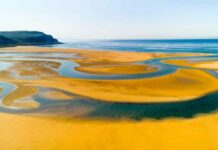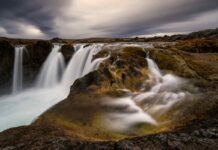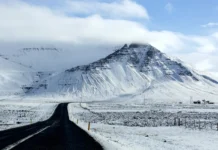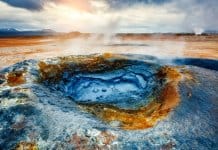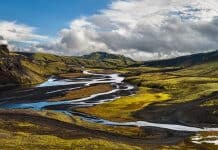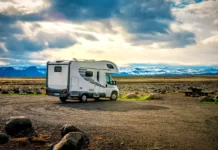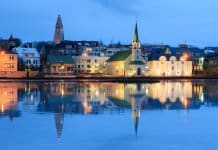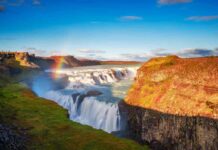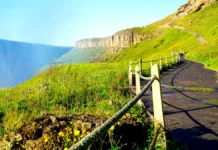Iceland is an adventurers’ paradise; are sprawling untamed landscapes will captivate your imagination, and make you fall in love with the great outdoors all over again. If you are searching for the perfect place to take an autumn or winter getaway, then look no further than Iceland. The fall and winter are traditionally the least popular times to visit our tiny island in the North Atlantic due to lack of vacation days and colder weather. However, in my opinion, it is actually the perfect time to book a trip to Iceland. Let me convince you why Iceland should be your next travel destination between the months of September and February.

Ease of Travel: Booking Flights
Being located the off the coast of Europe, and in the North Atlantic, has its challenges; the weather is temperamental, the winters are dark and long, and the rain can seem never-ending. You’ll need to pack lots of scarves, sweaters, and hats to keep you warm and toasty and your feet crunch the crisp, colorful fall leaves. However, getting here is a breeze. There are regular flights from mainland North America and from continental Europe. With the help of price aggregators, budget airlines, and flash sales on tickets, it is beyond easy to get here during the fall and winter seasons. So, while our snowy winter landscape is reminiscent of a distant, far-away land, it is actually right at your fingertips.
Ease of Travel: When You Land
Whoever designed our infrastructure here in Iceland must have been an avid fan of our naturally occurring attractions and sightseeing locations. The most famous road in Iceland is called the “Ring Road.” This route circumnavigates the entire country, and if you had a need for speed you could actually drive around the whole country in only 16 hours (however, I highly advise against this given the unstable weather and gravel roads). Slower is always better, especially during the cooler months. This route makes it a breeze to plan your very own Icelandic road trip, or if you are feeling up for something less intense, you could take a number of different day trips straight from Reykjavik. You need not worry about camping in the wilderness unless you really want to. You could explore most of Iceland’s backcountry and still make it back to Reykjavik for a hot helping of lamb stew. And who doesn’t love a steaming hot bowl of stew after a frosty trek?

The Offseason: The Best Season
Don’t get me wrong; I adore summer. The weather is perfect, the days are long, and it gives me a chance to forget about the long dreary winter nights. However, if you are visiting us from abroad, it may be more advantageous to visit Iceland during the offseason. Tourists flock to Iceland by the millions every summer. As such, the prices for everything skyrocket; accommodation, rental car prices, and food prices tend to increase during the summer months. However, once the fall makes its way to our country, everything changes. There is a mass exodus of tourists, the prices dip, and the island becomes free of wandering tourists. If you decide to brave Iceland in the winter months you will have access to cheaper options for car and motorhome rental, more options for accommodation, and generally will save a ton of money. Also, added bonus: you will actively help curb Iceland’s growing over-tourism problem. Coming during the off-season balances out the distribution of what time of year people come to visit.
Wintertime Activities
Iceland truly comes alive in the wintertime. Once the snow begins to fall, our best tours and expeditions finally return for all to enjoy. Whether it be snowmobiling on a glacier field, exploring the incredible ice and glacier caves, or taking a thrilling glacier hike through fields of opaque and off-white glaciers, there is plenty to do. Maybe you can even build an Icelandic snowman while you’re here. I personally love the wintertime and Christmastime in Iceland. I think that it is underrated, and if visitors were informed, they actually would have a better time in December, January, and February. Also, as I said, you will have the country to yourself. Meaning there will be more options for tours and expeditions. This will save you time and money in the long run.

The Northern Lights
Seeing the phrase “Northern Lights” automatically sparks images of brilliantly green and yellow waves of light pulsating across starry skies. Imagine how much more beautiful the Aururoa Borealis is when set against a snowy backdrop. The auroras are undoubtedly one of the main attractions here in Iceland, and you can only see them during the offseason. That means no Northern Lights in the summer, folks. Like glacier caves, witnessing the Northern Lights, in my opinion, is a solid bucket list item. Seeing videos and photos will never truly do this magnetic mystery justice. Bring a warm jacket, rub those lucky rabbit feet, and patiently wait to have your imagination open up when you see the glory that is the arctic wintertime aurora.
Why Iceland Should Be Your Next Fall or Winter Travel Destination
Iceland comes alive in the fall and winter, but I think it gets a bad reputation. The long lightless winters seem to dominate the collective conversation about Iceland during the offseason. However, there are so many aspects that make Iceland such a special place to visit for your next vacation. Don’t believe the hype surrounding the negatives of Iceland during the colder months. It is just as good, if not better than Iceland in the summer. Save some money, have your mind blown by the natural beauty, and come to visit us this fall or winter.

